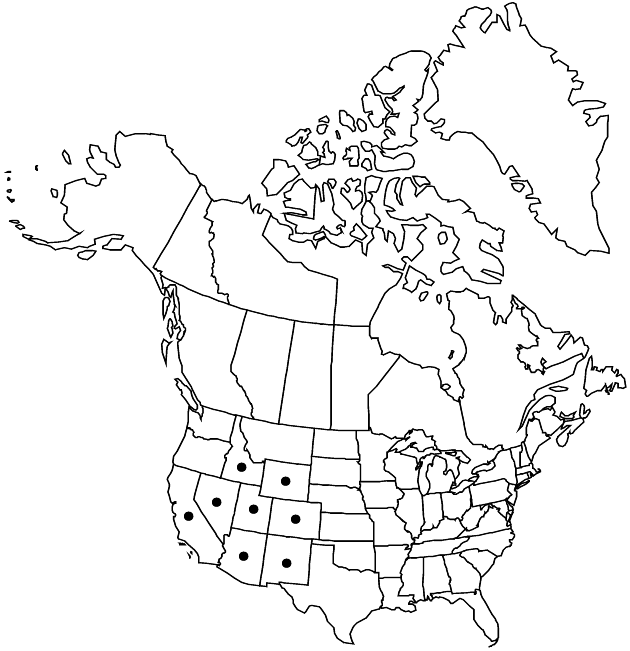Difference between revisions of "Erigeron concinnus"
Fl. N. Amer. 2: 174. 1841.
FNA>Volume Importer |
FNA>Volume Importer |
||
| Line 11: | Line 11: | ||
|name=Distasis concinna | |name=Distasis concinna | ||
|authority=Hooker & Arnott | |authority=Hooker & Arnott | ||
| + | |rank=species | ||
|publication_title=Bot. Beechey Voy., | |publication_title=Bot. Beechey Voy., | ||
|publication_place=350. 1839 | |publication_place=350. 1839 | ||
| Line 17: | Line 18: | ||
|name=E. pumilus var. concinnus | |name=E. pumilus var. concinnus | ||
|authority=(Hooker & Arnott) Dorn | |authority=(Hooker & Arnott) Dorn | ||
| + | |rank=variety | ||
}} | }} | ||
|hierarchy=Asteraceae;Asteraceae tribe Astereae;Erigeron;Erigeron concinnus | |hierarchy=Asteraceae;Asteraceae tribe Astereae;Erigeron;Erigeron concinnus | ||
| Line 32: | Line 34: | ||
--><p><i>Erigeron concinnus</i> has been treated within <i>E. pumilus</i>; G. L. Nesom (1983b) found that these species approach each other closely in geographic range without intergradation.</p> | --><p><i>Erigeron concinnus</i> has been treated within <i>E. pumilus</i>; G. L. Nesom (1983b) found that these species approach each other closely in geographic range without intergradation.</p> | ||
|tables= | |tables= | ||
| − | |references= | + | |references= |
| − | |||
| − | |||
| − | |||
}}<!-- | }}<!-- | ||
| Line 64: | Line 63: | ||
-->{{#Taxon: | -->{{#Taxon: | ||
name=Erigeron concinnus | name=Erigeron concinnus | ||
| − | |||
|authority=(Hooker & Arnott) Torrey & A. Gray | |authority=(Hooker & Arnott) Torrey & A. Gray | ||
|rank=species | |rank=species | ||
| Line 72: | Line 70: | ||
|family=Asteraceae | |family=Asteraceae | ||
|distribution=w United States. | |distribution=w United States. | ||
| − | |reference= | + | |reference=None |
|publication title=Fl. N. Amer. | |publication title=Fl. N. Amer. | ||
|publication year=1841 | |publication year=1841 | ||
|special status= | |special status= | ||
| − | |source xml=https://jpend@bitbucket.org/aafc-mbb/fna-data-curation.git/src/ | + | |source xml=https://jpend@bitbucket.org/aafc-mbb/fna-data-curation.git/src/eaa6e58056e40c9ef614d8f47aea294977a1a5e9/coarse_grained_fna_xml/V19-20-21/V20_604.xml |
|tribe=Asteraceae tribe Astereae | |tribe=Asteraceae tribe Astereae | ||
|genus=Erigeron | |genus=Erigeron | ||
Revision as of 19:29, 16 December 2019
Perennials, 4–25(–50) cm; taprooted, caudices simple or branched, branches sometimes rhizomelike. Stems ascending to erect, sparsely to densely hispido-pilose to glabrate, minutely glandular. Leaves mostly basal (usually persistent) or basal and cauline (petioles prominently ciliate, hairs spreading, thick-based); blades narrowly oblanceolate to linear-oblong, 10–50(–80) × 1–4 mm, margins entire, usually ciliate, faces usually hirsute to hirsuto-villous, sometimes substrigose to glabrate, eglandular; cauline unreduced or gradually reduced distally. Heads 1–5. Involucres 4–7 × 7–12(–15) mm. Phyllaries in 2–4 series (midvein region orange or yellowish), hirsute to hirsuto-villous, ± minutely glandular. Ray florets 50–100(–125); corollas white to pink or blue, 6–15 mm, laminae reflexing. Disc corollas 3–5 mm (throats indurate and inflated, hirsuto-strigose, hairs biseriate, sharply pointed). Cypselae 1.2–1.8 mm, 2-nerved, faces sparsely strigoso-hirsute; pappi: outer of scales (0.2–0.5 mm), inner of (7–)10–14(–15) bristles.
Distribution

w United States.
Discussion
Varieties 3 (3 in the flora).
Erigeron concinnus has been treated within E. pumilus; G. L. Nesom (1983b) found that these species approach each other closely in geographic range without intergradation.
Selected References
None.
Lower Taxa
Key
| 1 | Heads 1; stems ± scapiform | Erigeron concinnus var. condensatus |
| 1 | Heads (1–)2–3(–5, rarely –50); stems leafy (at least proximal 1/2) | > 2 |
| 2 | Stems densely piloso-hispid | Erigeron concinnus var. concinnus |
| 2 | Stems glabrous or sparsely hirsute or piloso-hirsute (hairs sometimes ascending-appressed near heads) | Erigeron concinnus var. subglaber |